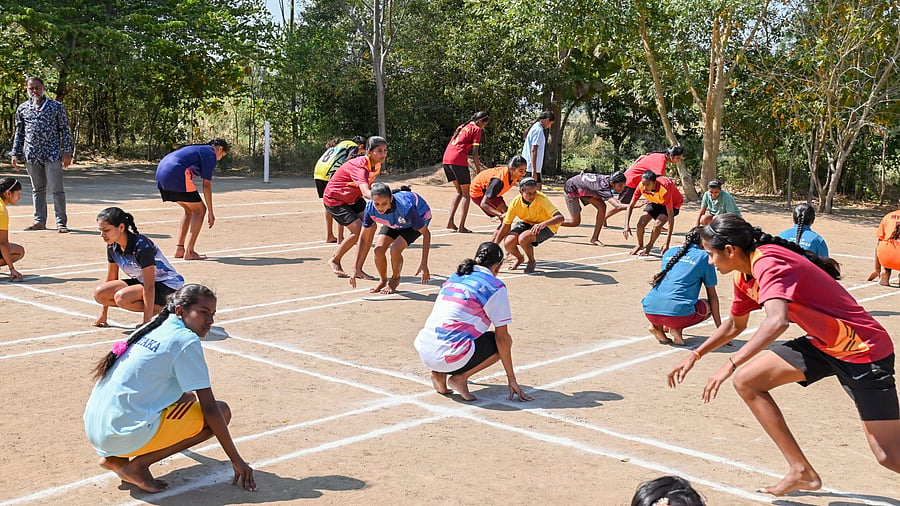
Kho kho players practising in Kuruburu village, T Narasipura taluk, Mysuru.
Photos by Anup Ragh T
It was one of the most exciting sights. A large group of girls at Kuruburu village in Mysuru’s T Narasipura stood before a pole made out of the thorny Acacia with clasped hands, and entered the court. One group of girls tried catching players from the opposite team, who were running as fast as blackbucks, the ones chasing glided like fish. The game was so intense that the players were soon drenched in sweat. They took a small break, and I seized the chance for a tete-a-tete.
“Why did you fold your hands and stand before the thorny Acacia pole?” I asked.
“We do not have a proper kho kho court even today. Initially, we used to practise in a narrow space in the coconut grove behind the school. As there were no poles there, we cut down an Acacia tree and used its branches. This pole initiated our kho kho journey, and so we always pray before it prior to our practice sessions,” explains coach Manjunath.
This is, in short, the story of the kho kho girls of Kuruburu. Chaitra, who represented India in the Kho Kho World Cup and won the ‘Player of the Match’ award, hails from this village.
Over a hundred girls from Kuruburu have dedicated themselves to playing the sport, earning recognition at the state, national and international levels. This has earned the village the title of ‘kho kho Kuruburu’.
Chaitra became famous after her performance in the World Cup. At the Vidyadarshini School in the village, there are hundreds of such kho kho talents. Interestingly, Kuruburu may be the only village in the state where almost every home has a kho kho player or an athlete.
The journey
It all began when a few students of Vidyadarshini School formed a kho kho team on their own and began preparing for a hobli-level competition, drawing the attention of Manjunath, their new math teacher. He observed the students practising diligently. Unfortunately, the students lost the competition and returned to school in tears.
Manjunath was moved, and encouraged them. However, he knew little about the sport. To keep his promise, he began reading books on kho kho, watching matches on television and noting down important strategies. He then began training the students.
This was in 2009. Soon, the Kuruburu team defeated the powerful Rangasamudra team from Mysuru, which had emerged as a champion the previous year. This victory gave the team much-needed confidence, and they trained even harder, winning trophies at the hobli, taluk and district levels.
In 2010, one of the players, Megha, got an opportunity to become part of the national team.
That year, Megha played for the Karnataka team, which emerged as the runner-up at the national level. She also won the ‘Best Player’ award. In 2016, Megha and Veena won a gold medal at the South Asian Games. This brought immense confidence to the Kuruburu team.
Many more girls were inspired to join the team, giving rise to separate senior and junior teams.
In 2018, the girls from Kuruburu won in both the junior and senior categories at a competition in Vijayanagar in Bengaluru. It was a remarkable achievement, especially considering that these girls practised in a coconut grove without proper facilities.
Challenges along the way
The team has faced several challenges, particularly with 15 players leaving in 2018 to join other teams, with the promise of better coaching and opportunities.
However, undeterred, Veena, Manjula, and Amulya of the senior team stood strong and decided to strengthen the junior team.
For a year, they abstained from participating in any tournaments and trained hard instead, marking the beginning of a new chapter in the Kuruburu success story. In 2020, the team re-emerged as champions, winning the state-level championship.
Three years later, Monica from the Kuruburu team represented India at the international level, helping India win the Asian Championship. Chaitra, who was part of the junior team then, was awarded ‘Player of the Match’ at the 2025 World Cup.
In spite of such success, Kuruburu does not have a dedicated kho kho practice court even today.
“Kuruburu has given rise to many talents but does not have a proper court. The donations we receive are utilised to buy uniforms and shoes for the players. It is high time the government provides proper facilities to support such rural talents,” says Kailasamurthy, a farmer in the village.
Despite receiving opportunities elsewhere, Manjunath has stayed at the school. “I have not done much. It is their hard work that has led these children to greater heights,” he says.
Many girls have even secured government jobs through the sports quota under Manjunath’s guidance.
“The soil of Kuruburu has a unique power,” says Manjunath. It is time the government recognises the achievements of the Kuruburu girls by establishing a kho kho academy in the village.
“Rangasamudra, Sosale and many other villages in T Narasipura taluk had strong kho kho teams earlier. Though the girls who played earlier might have given up kho kho for many reasons now, their contribution to the rise of kho kho in the region can never be forgotten,” says Manjunath.
“Parents supported their daughters despite various challenges. The parents’ progressive attitude has played a crucial role in their success,” he adds.
(Translated from Kannada by Divyashri Mudakavi)
Kho kho players practising in Kuruburu village T Narasipura taluk Mysuru.
Photos by Anup Ragh T
Kho kho players practising in Kuruburu village T Narasipura taluk Mysuru.
Photos by Anup Ragh T
Kho kho players practising in Kuruburu village T Narasipura taluk Mysuru.
Photos by Anup Ragh T
Kho kho players practising in Kuruburu village T Narasipura taluk Mysuru.
Photos by Anup Ragh T
Kho kho players practising in Kuruburu village T Narasipura taluk Mysuru.
Photos by Anup Ragh T